Ujjain from www.coinindia.com. part one.
The Swastika Coin Galleries: Ujjain.
This page authored by Wilfried Pieper
Avanti in ancient western Malwa was one of the Mahajanapadas and Ujjain was the dominant urban center of that region. It was described as a very fertile land of mild climate with a prosperous and flourishing trade. Particular mention was made of agricultural products, cotton crafts, a highly developed iron industry, mineral resources, ivory, pearls, corals and precious stones. Trade routes crossed at Ujjain connecting it closely with the other trade centers of that time. In the 4th century BC Avanti lost its independence being henceforth a province of the Mauryan Empire. Before he became king himself, Asoka was appointed as viceroy of Ujjain by his father, king Bindusara. After Asoka's death weak successors followed him and central control soon diminished giving way to local independence.
There are good reasons to assume that the local Ujjain copper issues started about or shortly after 200 BC. The close affinities to the Mauryan silver karshapanas in style, use of symbols and symbol arrangements support this view and so does the occurrenc of the 'bale-mark' symbol on the reverses of some Ujjain coins. Of course there was a continued use of Mauryan silver karshapanas and tiny silver/ billon masakas and some early uninscribed cast copper types were still issued at Ujjain during the first half of the 2nd century BCE. Western Malwa copper versions of the Mauryan silver karshapana type GH566 (first coin below) illustrate the transition period after which new designs were developed, frequently as an arrangement of five different devices like on the Mauryan karshapanas but now composed in one single die.
These die-struck local coppers appear in great numbers and in many types- not astonishing in view of the commercial importance of the Ujjain region, where these coppers served day to day transactions and local trade affairs. The series was issued for a long period and stopped only when the Satavahanas incorporated Malwa into their ever growing empire around the middle of the 1st century BC. These coins were extremely popular and their continued use after their production had stopped, is suggested by association with coins of the period 100-300 CE - as it was likewise the case with Mauryan silver karshapanas which were popular as a medium for long-distance trade and large transactions even hundreds of years after their time of issue.
The depictions on these coins were obviously influenced by religious motifs, which were strong elements of the cultural and social life of the people of Ujjain, like anywhere else in India. But the main purpose of this long-lived, diverse and challenging series of local die-struck coppers was to supply the local markets with enough money to comply with the needs of a community so deeply involved in commercial activities. Only one type of the series bears the city-name, a few types bear personal names, but the vast majority are anonymous. The characteristic reverse design, the cross with a circle at each end, became the 'trade mark' of Ujjain coins and is thus well known as 'Ujjain symbol', even though it also appears on many coins outside the Ujjain region. Weights differ widely within the series from pieces of less than 0.5g to heavy weights of 25g (the heaviest recorded specimen offered at a public auction weighed 25.8g).
Devices frequently seen on Ujjain coins are symbols and animals comparable to those on other coins of ancient India. Many of such symbols refer to different forms of nature worship among them celestial symbols, mountains, trees, water-ponds and rivers and among the animals bull, elephant, horse and lion occupy a prominent position. Of special interest are human depictions as they are among India's earliest representations of deities in anthropomorphic form and thus most important for the iconographic development of these deities. In most cases single human figures are depicted, standing, squatting, dancing or sitting, representing various HIndu gods and goddesses. Different researchers have tried to identify them and have frequently come to divergent conclusions. The matter is not simple as in this early stage of iconography the depiction of a deity together with its characteristic symbols and attributes was not yet fully developed and sometimes different deities were even associated with the same symbols. The latest approach to the subject is Devendra Handa's brilliant paper on 'Divinities on Ujjain Coins', ICS-NL 51, 2013' who clarified controversies on some deities and originally proposed the identification of others. The most prominent figure on these coins is ceratainly Shiva Mahakala whose cult was most important at Ujjain, and Lakshmi who experienced a general adoration by believers of different cults who wouldn't have hesitated to beg assistance from the goddess of wealth, prosperity and fortune. But apart from Shiva and Lakshmi other deities are also depicted on the coins of ancient Ujjain, such as Karttikeya, Shashthi, Vasudhara, Krishna, Brahma and others, according to the well-founded identifications of Devendra Handa.
Ujjain: Shiva types.
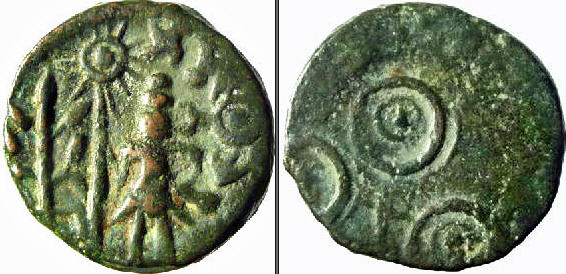
Ujjain, anonymous AE 3/4 karshapana, 'standing Shiva type'
Weight: 7.22 gm., Dimensions: 17 mm.
Standing Shiva holding danda in right and kamandalu in left; sun above railed tree on left and 6-armed symbol on right; taurine and svastika on top.
Double-orbed Ujjain symbol
Reference: Pieper 268 (plate coin)
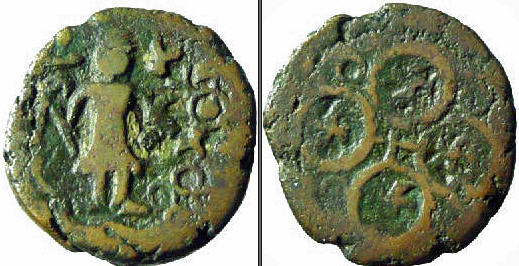
Ujjain, anonymous AE 1/2 karshapana, 'standing Shiva type'
Weight: 4.26 gm., Dimensions: 16 mm.
Standing Shiva holding danda and kamandalu; railed tree on left; six-armed
symbol above unconnected Ujjain symbol on right; river line at bottom.
Ujjain symbol with a svastika inside each orb and circles in the angles.
Reference: Pieper 271 (plate coin)
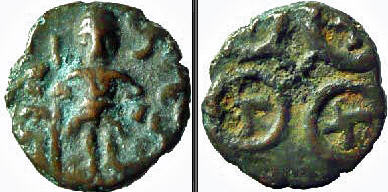
Ujjain, anonymous AE, 'standing Shiva type'
Weight: 1.64 gm., Dimensions: 13 mm.
Standing Shiva holding danda and kamandalu; railed tree on left; svastika on top; cakra on right.
Ujjain symbol with a svastika in each orb.
Reference: Pieper 273 (plate coin) / BMC, pl.XXXVIII, no.10

Ujjain, anonymous AE 3/8 karshapana, 'standing Shiva-like type'
Weight: 3.34g, Dimensions: 12 mm
Standing male deity both hands akimbo, danda in right; three-arched hill above river on left; cakra above railed tree on right.
Ujjain symbol with a svastika in each orb and footprints in angles.
Reference: Pieper 274 (plate coin) / Kothari 234 (who saw the footprints as taurines).
The depiction of the footprint (paduka) of a deity is a well known symbol of worship but it allows no attribution to a specific deity, as this symbol was used by followers of different deities, among them Buddha, Shiva and Vishnu.
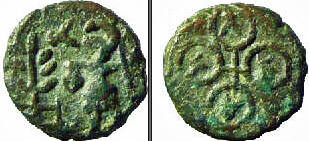
Ujjain, anonymous AE, 'crested standing Shiva type'
Weight: 0.72 gm., Dimensions: 9 mm.
Crested Shiva standing to left holding danda and kamandalu; railed tree on left; taurine on top.
Ujjain symbol with alternating svastikas and taurines in its orbs.
Reference: Pieper 282 (plate coin) / BMC, pl.XXXVIII, nos. 11-12
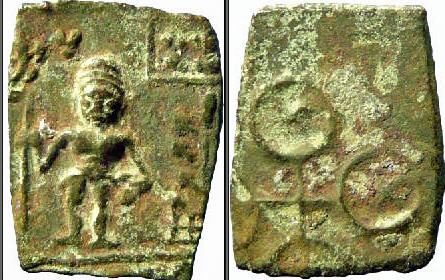
Ujjain, anonymous AE 3/8 karshapana, 'standing Shiva type'
Weight: 3.16 gm., Dimensions: 18x14 mm.
Standing Shiva holding danda and kamandalu; cakra above svastika and standard on left; fish-tank above railed tree on right; river at the bottom.
Ujjain symbol with a svastika in each orb.
Reference: Pieper 289 (plate coin) / BMC, pl.XXXVII, nos.19-20
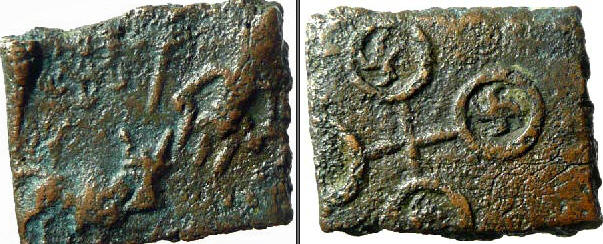
Ujjain, anonymous AE 1/2 karshapana, 'standing Shiva + nandi type'
Weight: 5.03 gm., Dimensions: 17x15 mm.
Standing Shiva holding danda and kamandalu, nandi on the left facing towards the viewer; cakra and Indradhvaja on top; parts of tree on right.
Ujjain symbol with a svastika in each orb.
Reference: Pieper 318 (plate coin)

Ujjain, anonymous AE 2 karshapana, 'standing Shiva + nandi type'
Weight: 15.53 gm., Dimensions: 26x21 mm.
Standing Shiva on right with nandi on left facing towards the deity; railed tree in center between Shiva and bull; taurines on top and a svastika on right bottom; river with diverse aquatic creatures at the bottom.
Double-orbed Ujjain symbol with an extra arm topped by a taurine in each angle.
Reference: Pieper 322 (plate coin)
An unusual heavy weight standard for the series. The heaviest recorded specimen offered at a public auction weighed 25.8 gm thus roughly representing a triple copper karshapana
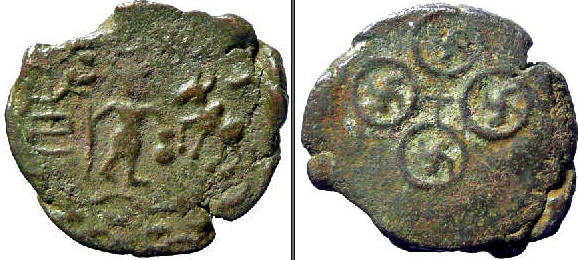
Ujjain, anonymous AE 1/2 karshapana, 'standing Shiva+ nandi type'
Weight: 3.40 gm., Dimensions: 18 mm.
Standing Shiva holding danda and kamandalu; bull facing the deity from the right;
Ujjain symbol on top; railed tree on left; river at the bottom.
Ujjain symbol with a svastika in each orb.
Reference: Pieper 311 (plate coin)
Ujjain diverse deities.

Central India, AE 1/8 karshapana,'fish-holding Vasudhara'
Weight: 1.01 gm., Diameter: 8x8 mm.
Standing goddess Vasudhara holding a pair of fish with her outstretched right, left hand akimbo; she wears large earrings and pinned up hair (as if wearing a vessel on her head); svastika on the top left. Lion standing to right
Reference: Pieper 452 (plate coin)
The provenance of this and the next coin is uncertain but may be assumed to be in western Malwa or closely linked regions south of the Narmada.

Ujjain, anonymous AE 3/4 karshapana, 'taurine-holding deity'
Weight: 3.00gm., Diameter: 15x14 mm.
Frontally standing female figure holding taurine in raised left, right akimbo;
chakra above Ujjain symbol on left; svastika above railed tree on right.
Ujjain symbol with a svastika in each orb.
Reference: Pieper 298 (plate coin)/ BMC pl.XXXVII, no.8
The identity of this taurine holding female remains uncertain at the moment.

Ujjain, anonymous AE 1/4 karshapana, 'six-headed Shashthi type'
Weight: 1.95 gm., Diameter: 14x12 mm.
Simplified female figure frontally standing, both arms hanging down; railed tree on right; river line at the bottom.
Ujjain symbol with svastika in each angle.
Reference: Pieper 300 (plate coin)
Referring to depictions of six-headed Shashthi on some Yaudheya coins Devendra Handa takes the five dots around the main head of the female on this coin type as additional heads and identifies her as Shashthi on this Ujjain type as well (ICS-NL, 51, p.34).

Ujjain, anonymous AE 3/8 karshapana,'Balarama & ass-demon'
Weight: 3.86 gm., Diameter: 15x14 mm.
Human figure on left holding stick and kamandalu standing towards a horse-like animal which faces him from right; palm tree on right; Ujjain symbol on top; a taurine above the animal and taurine and svastika at the bottom.
Ujjain symbol with a svastika in each orb and taurines in the angles.
Reference: Pieper 346
In a note to the SACG website Shailendra Bhandare suggested the scene on this coin representing the mythical story of 'Balarama killing the ass demon' and the depiction seems to reflect that story indeed quite well- even if the deity on this coin has no specific Vaishnavite attributes. We are told that there had been a large grove where there were palmyras bearing delicious fruits. But nobody dared to go there because the site was guarded by Dhenuka, a demon in the form of an ass. Finally Balarama, inseparable companion of Krishna, killed the demon by crashing him against one of the palm trees. In his contribution to 'Between the Empires' Bhandare discusses the story of 'Balarama killing the ass-demon' in the context of the coinage of Erikachha where the palm-tree and ass had been characteristic coin devices. Typologically this coin type may thus rather belong to Erikachha than to Ujjain.
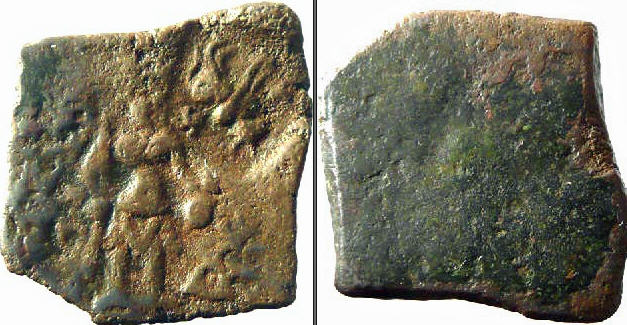
Ujjain region, c/m anonymous AE 1/2 karshapana
Weight: 3.96 gm., Diameter: 17x17 mm.
Standing male figure holding kamandalu (water-pot) and danda (stick); wheel above six-armed symbol on left; three-arched hill with crescent
on top right; countermark on top right depicting a bull with svastika and taurine.
Blank reverse.
Reference: Pieper 417 (plate coin) / see Kothari 267 for undertype